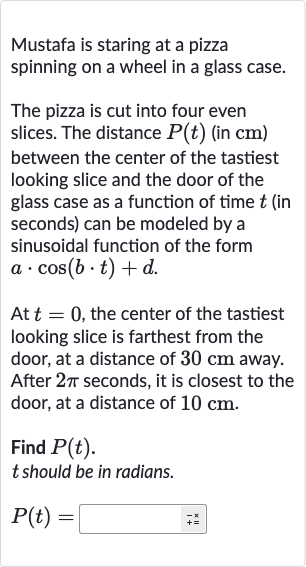AI tutor
Welcome to Bytelearn!
Let’s check out your problem:

Mustafa is staring at a pizza spinning on a wheel in a glass case.The pizza is cut into four even slices. The distance (in ) between the center of the tastiest looking slice and the door of the glass case as a function of time (in seconds) can be modeled by a sinusoidal function of the form .At , the center of the tastiest looking slice is farthest from the door, at a distance of away. After seconds, it is closest to the door, at a distance of .Find . should be in radians.
Full solution
Q. Mustafa is staring at a pizza spinning on a wheel in a glass case.The pizza is cut into four even slices. The distance (in ) between the center of the tastiest looking slice and the door of the glass case as a function of time (in seconds) can be modeled by a sinusoidal function of the form .At , the center of the tastiest looking slice is farthest from the door, at a distance of away. After seconds, it is closest to the door, at a distance of .Find . should be in radians.
- Given Information: We are given that the distance is modeled by a sinusoidal function of the form . At , the distance is the maximum, which is . This means that the value of plus must equal , since the cosine function has its maximum value of at .
- Maximum Distance: We also know that after seconds, the distance is at its minimum, which is . This means that the value of must equal , since the cosine function has its minimum value of at for the first time.
- Minimum Distance: From the two conditions, we can set up a system of equations:. . Adding these two equations, we get , which means .
- System of Equations: Subtracting the second equation from the first, we get , which means .
- Solving for : Now we need to determine the value of . Since the pizza completes one full cycle from the farthest point to the closest point and back to the farthest point in seconds, the period of the function is
4 4 T of a cosine function is given byT = \frac{ , so we have2 2 4 4 2 2 - Solving for
a a b b b = 2 π 4 π = 1 2 b = \frac{2\pi}{4\pi} = \frac{1}{2} - Determining the Value of b: Now we have all the parameters for the sinusoidal function:
a = 10 a = 10 b = 1 2 b = \frac{1}{2} d = 20 d = 20 P ( t ) P(t) P ( t ) = 10 cos ( 1 2 t ) + 20 P(t) = 10\cos\left(\frac{1}{2}t\right) + 20
More problems from Interpret parts of quadratic expressions: word problems
QuestionGet tutor help
QuestionGet tutor help
QuestionGet tutor help
QuestionGet tutor help
QuestionGet tutor help
QuestionGet tutor help
QuestionGet tutor help
QuestionGet tutor help
QuestionGet tutor help
